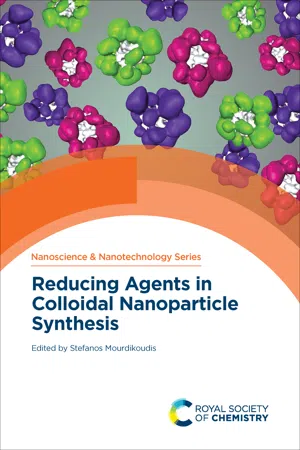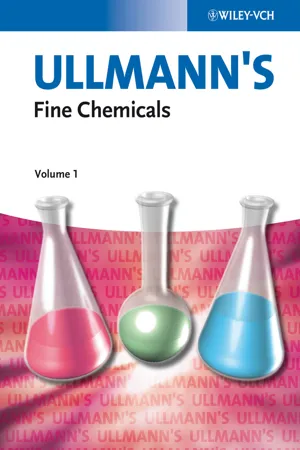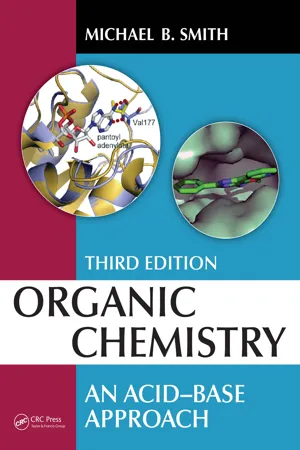Chemistry
Carboxylic Acids
Carboxylic acids are organic compounds containing a carboxyl group (COOH). They are characterized by their acidic properties and are found in many natural substances, such as vinegar and citrus fruits. Carboxylic acids are important in organic synthesis and are used in the production of pharmaceuticals, fragrances, and polymers.
Written by Perlego with AI-assistance
Related key terms
7 Key excerpts on "Carboxylic Acids"
- eBook - ePub
Understanding Advanced Organic and Analytical Chemistry
The Learner's ApproachRevised Edition
- Kim Seng Chan, Jeanne Tan;;;(Authors)
- 2016(Publication Date)
- WS EDUCATION(Publisher)
CHAPTER 10
Carboxylic Acids and Their Derivatives
10.1 Introduction
Carboxylic Acids are organic compounds that contain the following carboxyl functional group, denoted as –COOH.From the constitutional/structural formula, the carboxyl functional group is a composite of a carbonyl functional group and a hydroxyl group. Similar to that in carbonyl compounds, the carbon atom of the carboxyl functional group is sp2 hybridized and trigonal planar in shape. Thus, it is not surprising that Carboxylic Acids possess physical and chemical properties similar to both the carbo nyl and hydroDerivatives of Carboxylic Acids have the –OH group substituted. For instance, esters contain the functional group –COOR, and acid chlorides the –COCl group.xylcompounds.10.2 Nomenclature
Carboxylic Acids are named with the suffix –oic acid. Other substituents are named as prefixes accompanied by the appropriate positional numbers. If the carboxylic acid group is considered a substituent, then it is named as the –carboxy prefix (notice that the prefix is not “carboxyl”).10.3 Physical Properties
10.3.1 Melting and Boiling Points
Melting and boiling points increase with increasing carbon chain length (Table 10.1 ) and decrease with increasing degree of branching. As with alcohols, the trend is accounted for by the increasing strength of instantaneous dipole–induced dipole (id–id) attractive forces due to the greater number of electrons accompanying the increasing carbon chain length, rather than hydrogen-bonding.Table 10.1The boiling points of Carboxylic Acids are higher than those of their isomeric ester counterparts (Table 10.2 - eBook - ePub
MCAT Organic Chemistry Review 2024-2025
Online + Book
- (Author)
- 2023(Publication Date)
- Kaplan Test Prep(Publisher)
CHAPTER 8Carboxylic Acids
In This Chapter
Nomenclature Physical Properties8.1 Description and Properties8.2 Reactions of Carboxylic AcidsSynthesis of Carboxylic Acids Nucleophilic Acyl Substitution Reduction Decarboxylation SaponificationConcept SummaryCHAPTER PROFILE
The content in this chapter should be relevant to about 9% of all questions about organic chemistry on the MCAT. This chapter covers material from the following AAMC content category:5D: Structure, function, and reactivity of biologically-relevant moleculesIntroduction
Carboxylic Acids, with both carbonyl and hydroxyl groups, are some of the most reactive organic molecules you’ll encounter on Test Day. As we will see in this chapter, these molecules can react as acids (as their name suggests), nucleophiles, and electrophiles and are integral to many biological processes. Carboxylic Acids are found in soaps, oils, preservatives, skin care products, clothing, and—most importantly for the MCAT—amino acids. Carboxylic Acids often have strong, unpleasant odors. For example, acetic acid (ethanoic acid) is the main ingredient in vinegar; propionic acid (propanoic acid) gives Swiss cheese its smell; butyric acid (butanoic acid) is found in rancid butter and body odor.So what makes Carboxylic Acids so interesting and versatile? First, they’re acids, so they like to give away protons—particularly because when they do so, the remaining negative charge resonates between two oxygen atoms, making the anion very stable. This makes Carboxylic Acids some of the most acidic compounds encountered in organic chemistry, with pKa values between 3 and 6. Compare this with alcohols, which have an average pKa - Stefanos Mourdikoudis, Stefanos Mourdikoudis(Authors)
- 2021(Publication Date)
- Royal Society of Chemistry(Publisher)
Their chemical structure contains a carbonyl function (–C=O) and a hydroxyl group (OH). These groups interact easily with polar compounds, forming bridges of H and obtaining high boiling points. The carbonyl group (C=O) is considered one of the most functional groups involved in many important reactions. The Carboxylic Acids are the foremost important functional group that present C=O. 11, 12 Under certain conditions, proton donors i.e. Carboxylic Acids, transfer H + (protons) through heterolysis. This type of organic compound can be obtained by different routes: some Carboxylic Acids, such as citric acid, lactic acid, or fumaric acid, are produced by fermentation, and most of these types of Carboxylic Acids are applied in the food industry. 13 Historically, some Carboxylic Acids were produced by sugar fermentation. There are numerous synthesis reactions of Carboxylic Acids, like oxidation from alcohols within the presence of strong oxidants like KMnO 4 and oxidation of aromatic compounds among other routes. 14 Derivatives of carboxylic acid, such as alkyl halides, esters, and amides, find different applications in diverse areas. In the case of esters, these are obtained from the reaction between Carboxylic Acids and alcohols in the presence of an acid catalyst, usually H 2 SO 4, with heat; this type of reaction is known as esterification. 15 In the case of the amides, they are obtained in the presence of an amine, which can be primary and secondary, with a carboxylic acid- eBook - ePub
- Graham Patrick(Author)
- 2004(Publication Date)
- Taylor & Francis(Publisher)
This distinguishes Carboxylic Acids and their derivatives from aldehydes and ketones where the corresponding atom is hydrogen or carbon. This is important with respect to the sort of reactions which Carboxylic Acids and their derivatives undergo. The carboxylic acid group (COOH) is often referred to as a carboxyl group. Figure 1. (a) Acid chloride; (b) acid anhydride; (c) ester; (d) amide; (e) carboxylic acid. Figure 2. Structure of the functional group. Bonding The bonds in the carbonyl C=O group are made up of a strong σ bond and a weaker π bond (Figure 3). Since oxygen is more electronegative than carbon, the carbonyl group is polarized such that the oxygen is slightly negative and the carbon is slightly positive. This means that oxygen can act as a nucleophilic center and carbon can act as an electrophilic center. Figure 3. Bonding and properties. Properties Carboxylic Acids and their derivatives are polar molecules due to the polar carbonyl group and the presence of a heteroatom in the group Y. Carboxylic Acids can associate with each other as dimers (Figure 4) through the formation of two intermolecular hydrogen bonds which means that Carboxylic Acids have higher boiling points than alcohols of comparable molecular weight. It also means that low molecular weight Carboxylic Acids are soluble in water. However, as the molecular weight of the carboxylic acid increases, Figure 4. Intermolecular H-bonding. the hydrophobic character of the alkyl portion eventually outweighs the polar character of the functional group such that higher molecular weight Carboxylic Acids are insoluble in water. Primary amides and secondary amides also have a hydrogen capable of hydrogen bonding (i.e. , RCON H 2, RCON H R′), resulting in higher boiling points for these compounds compared to aldehydes and ketones of similar molecular weight. Acid chlorides, acid anhydrides, esters, and tertiary amides are polar, but lack a hydrogen atom capable of participating in hydrogen bonding - eBook - ePub
- (Author)
- 2014(Publication Date)
- Wiley-VCH(Publisher)
Aliphatic hydroxyCarboxylic Acids may have one or several hydroxyl groups, together with one or more carboxyl groups. In the simplest case, the monohydroxymonoCarboxylic Acids, the compounds can be conveniently subdivided into three categories:1. 2- or α -hydroxyCarboxylic Acids,2. 3- or β-hydroxyCarboxylic Acids, and3. hydroxyCarboxylic Acids with the hydroxyl group located in the 4- (i.e., γ -) position, or even more remote from the carboxyl group.Table 1 lists several commercially important hydroxyCarboxylic Acids and related compounds, grouped in accordance with the above scheme.Table 1. Commercially important hydroxyCarboxylic Acids and derivatives.2. General Characteristics
The overall characteristics of a hydroxycarboxylic acid are a function of the number of hydroxyl and carboxylic acid groups present as well as their relative placement.2.1. Physical Properties
Most naturally occurring hydroxyCarboxylic Acids are chiral and thus exhibit optical activity. In pure form, they are usually crystallizable. HydroxyCarboxylic Acids have exceptionally high boiling points relative to corresponding unsubstituted acids with the same chain length. This is a consequence of association among the hydroxyl groups. For this reason, many of these compounds cannot be distilled without decomposition, even under vacuum.Table 2 summarizes the physical properties of the commercially important hydroxyCarboxylic Acids and their derivatives listed in Table 1 .Table 2. Physical properties of the hydroxyCarboxylic Acids listed in Table 12.2. Chemical Properties
HydroxyCarboxylic Acids readily form the expected salts at the carboxyl group. The acidity of α - eBook - ePub
Organic Chemistry Study Guide
Key Concepts, Problems, and Solutions
- Robert J. Ouellette, J. David Rawn(Authors)
- 2014(Publication Date)
- Elsevier(Publisher)
20 Carboxylic Acids Keys to the Chapter 20.1 The Carboxyl and Acyl Groups The reactivity of the carboxyl group depends on the interplay of its π electrons, its nonbonded electron pairs, and the hydroxyl group. The carboxyl group is resonance stabilized, with two contributing dipolar resonance structures. The lone-pair electrons of the hydroxyl oxygen atom are donated to the electron-deficient carbon atom in one dipolar resonance structure. As a result, the electron density of the carbonyl carbon atom in a carboxylic acid is larger than for aldehydes and ketones. Carboxylic Acids are the “parents” of acid derivatives. The acyl group, RCO, is bonded to an electronegative atom in Carboxylic Acids and their derivatives. The acyl group of an ester is bonded to the oxygen atom of an alkoxy group. The acyl group of an amide is bonded to a nitrogen atom. Cyclic esters and amides are lactones and lactams, respectively. The acyl group is bonded to a chlorine atom, a carboxyl group, and a thiolate group in acid chlorides, acid anhydrides, and thioesters, respectively. 20.2 Nomenclature of Carboxylic Acids The common names of the unbranched Carboxylic Acids do not provide information about the number of carbon atoms contained in the chain, so the common names simply have to be learned. Carbon atoms in the parent chain are named with Greek lower case letters (α, β, γ, etc.) starting with the carbon atom directly bonded to the carboxyl carbon atom. Branches on the chain are indicated using these Greek letters to identify the location of substituents or alkyl groups. IUPAC names of Carboxylic Acids are based on the alkane names, for which the suffice - oic acid replaces the final - e in the name of the alkane. The carbon chain is numbered starting with the carboxyl carbon atom, but the number 1 is not included in the name, since C-1 is automatically reserved for the carboxyl group - eBook - ePub
Organic Chemistry
An Acid-Base Approach
- Michael B. Smith(Author)
- 2022(Publication Date)
- CRC Press(Publisher)
a values that typically range from 1–6 (Sections 6.2–6.3). An acid-base reaction of a carboxylic acid with sodium amide is shown, generating the resonance-stabilized carboxylate anion and the conjugate acid, ammonia (Section 6.3).The IUPAC nomenclature for Carboxylic Acids identifies the longest continuous chain for the acid that contains the CO2 H unit. The carboxyl is the locant and it is always C1 so 1- is omitted from the name. The suffix for Carboxylic Acids is -oic acid , and “acid” is separated from the first part of the name. Examples are 2-(1–methylethyl)-5-methylhexanoic acid and 4-ethyl-5-phenylheptanoic acid. Carboxylic Acids that have a carboxyl group attached to a ring are named as the cyclic alkane carboxylic acid, as in 4-bromo-1-ethyl-5-methylcycloheptane-1-carboxylic acid. The ring carbon bearing the COOH unit is identified as C1 and the substituents are assigned the lowest number based on the carboxyl. Many simple Carboxylic Acids are known primarily by their common names. These include formic acid, acetic acid, propionic acid, butyric acid, valeric acid, and pivalic acid.Formic and acetic acids are used for the manufacture of paints, adhesives, and coatings. Vinegar contains acetic acid. Propanoic acid is used as a food preservatives in animal feed and it is used in baked goods and cheese to kill microorganisms that can lead to spoilage. Butyric acid is used in the treatment of disorders of the digestive tract, and it is responsible for the disagreeable odor of rancid butter.- 18.1 Write out the structure of 3-bromo-4-ethylnonanoic acid.
18.2 Carboxylic Acid Derivatives: Structure and Nomenclature
Acid chlorides, Anhydrides, Esters, AmidesThere are four important derivatives of Carboxylic Acids in which the OH connected to the carbonyl in RCOOH is replaced by a halogen, a carboxyl, an alkoxy or an amino group. When the group is a halogen, the molecule is an acid halide , where the OH unit in RCOOH is replaced with Cl, Br or I. When the halogen is chlorine, the molecule is an acid chlorid e. When OH is replaced by bromine the molecule is called an acid bromide . An acid anhydride is formed when the OH group is replaced by a carboxyl unit (O2
Learn about this page
Index pages curate the most relevant extracts from our library of academic textbooks. They’ve been created using an in-house natural language model (NLM), each adding context and meaning to key research topics.






